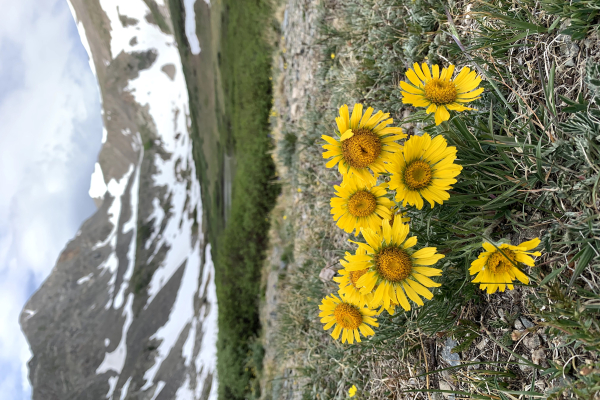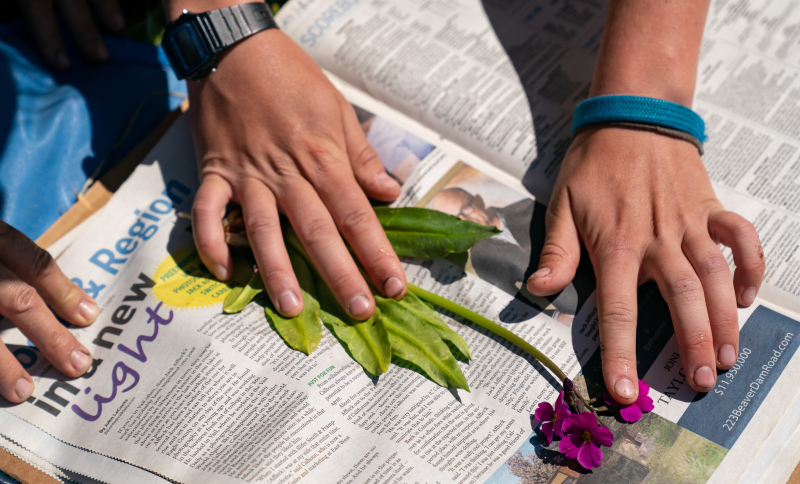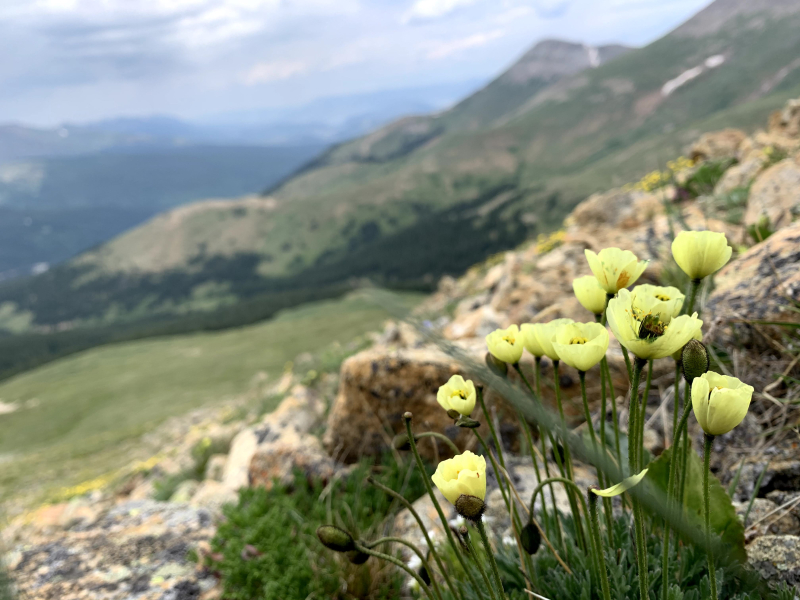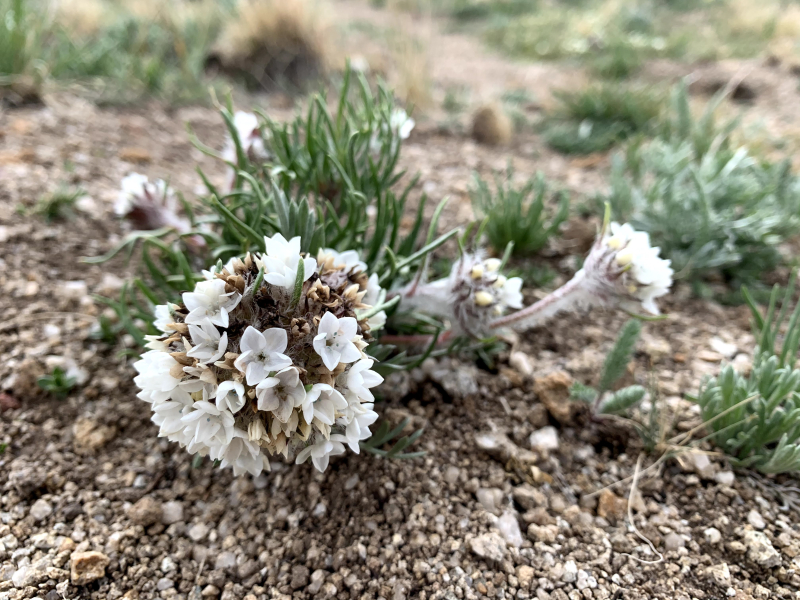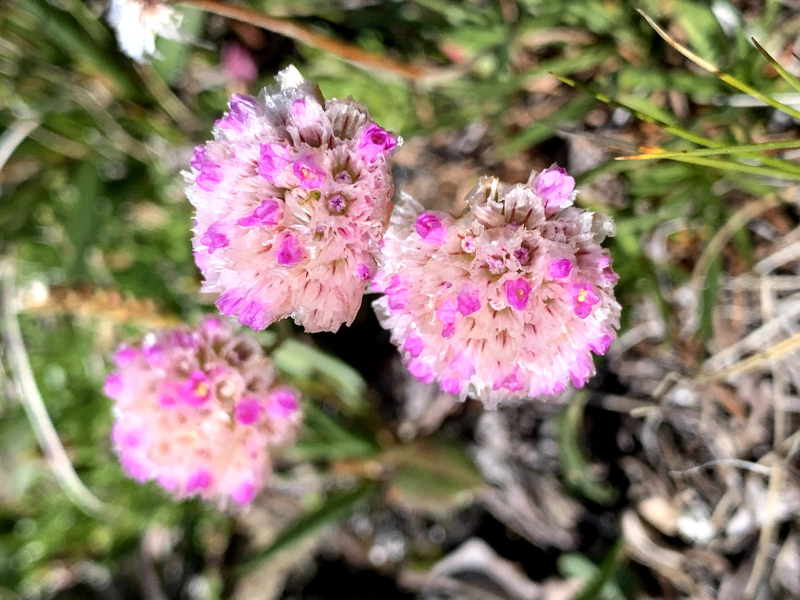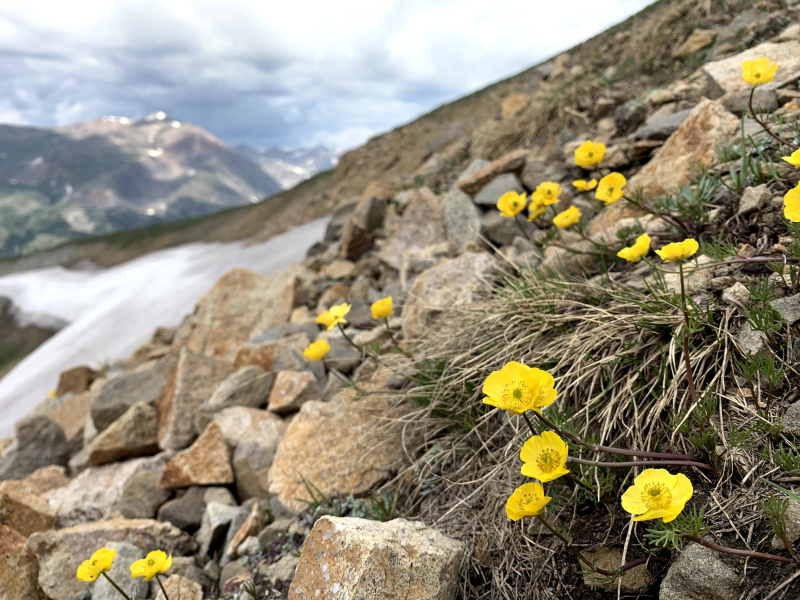IT’S BEEN AN exciting and productive couple of years for our alpine conservation efforts here at Betty Ford Alpine Gardens. The recently published Alpine Strategy (officially, the North American Botanic Garden Strategy for Alpine Plant Conservation) has been getting attention from other gardens and organizations interested in participating, and we are looking forward to engaging these partners as we develop the Alpine Strategy Network. I joined the Betty Ford Alpine Gardens team in June 2020 as the gardens’ first conservation scientist with the primary purpose of my position to implement the Alpine Strategy. My job is not only to coordinate the project but also to work on our conservation goals in the field.
These past two summer field seasons, we’ve focused on seed collecting, which is part of our goal to “Conserve 60% of all identified alpine plant species in North America ex-situ by 2030.” Ex-situ refers to conservation work that happens off-site, like back in the lab or an herbarium. Seed collecting and banking is an important component of ex-situ conservation because it allows us to preserve a portion of the species’ genetics and to study the germination strategies of these alpine species. Don’t miss Alex Seglias’ article about the exciting experimental seed banking and propagation work she does later in this issue. Throughout the summer season, we document the alpine plant diversity at each site we visit, using a dichotomous key (our favorites are Flora of Colorado by Jennifer Ackerfield and Alpine Flower Finder, the Key to Rocky Mountain Wildflowers Found Above Treeline by Janet L. Wingate and Loraine Yeatts) to ensure correct species identification. These records are called floristic inventories and are one way that we can track how species composition changes over time when we revisit these sites in five or ten years.
We also record any population of alpine plants that could support a seed collection and revisit it throughout the season to check how the seeds are developing. Last year, many populations of alpine plants did not produce or aborted seeds due to a couple of dry weeks in the middle of the season; and while this isn’t unusual, it can be disappointing. The goal is to collect enough seeds to send to a seed bank for long-term storage, usually about 3,000 seeds, representing genetic diversity from the population, and most importantly, not impacting the population’s reproductive chances. We adhere to the Center for Plant Conservation’s Best Plant Conservation Practices to Support Species Survival in the Wild. The seeds we collect are cleaned, counted, and the bulk of each collection is sent to the National Lab for Genetic Resource Preservation in Fort Collins, a world-renowned seed vault and research institution that is part of the USDA (United States Department of Agriculture). A small portion of each collection is kept to be stored here at Betty Ford Alpine Gardens, where it will be used in the Gardens as a living collection, another way to preserve these species ex-situ. And a very small amount of seed was sent to some of our collaborators at other botanical gardens to be grown in their collections as additional backup populations.
We also collect herbarium specimens. These are dried plant samples for study and can include plant materials, seeds, pollen, wood sections, and more. We collect a plant specimen by digging one individual up, taking care to include the root and as many identifiable features as possible. We also record where it was found and other data points. Then we lay it flat in a field press for transport back to the lab, where we use newsprint and blotter paper to help suck out all the moisture in a plant press. The result is a two-dimensional representation of the plant, hopefully with most of its characteristics intact.
The amazing thing about herbarium specimens is that once they are dried, they can last many years. There are herbarium specimens from some of the first expeditions to the Rockies that showcase the first scientifically named specimen of our common alpine species! These herbarium specimens are another way to document plant diversity and distribution, and we often check the herbarium records for any new areas we plan to visit to see what taxa have been found there previously. For any population of plants that we plan to collect seed from, we take an herbarium specimen early in the season when it is flowering rather than when it is in seed, as it can be harder to identify when it’s all dried out and crunchy. These herbarium specimens serve as a “voucher” or proof of the species from which seeds were collected, and they are housed at the Kathryn Kalmbach Herbarium at Denver Botanic Gardens (DBG). Our permits through the U.S. Forest Service require us to have a voucher specimen for each seed collection we make, and we also submit a record of everything we collect so that collecting can be monitored.
As part of the objectives laid out in the Alpine Strategy, we aim to document biodiversity in alpine environments, especially in areas of high biological value. These areas are designated as Important Plant Areas, or IPAs: places of exceptional botanical richness or that support an outstanding assemblage of rare and endemic plant species. Here in Colorado, the Colorado Natural Heritage Program has identified about 200 IPAs rated B1: “Outstanding Biodiversity Significance”, and B2: “Very High Biodiversity Significance.” And around 30 of these highly-ranked sites are in the alpine. This leads us to our goal to protect 50% of the most important plant areas for alpine plant conservation in North America by 2030. The goal is to not only identify the most significant IPAs, but to also work with land managers to make sure these sites are well protected. In the two field seasons since we began the targeted work on the strategy, our conservation team visited three highly ranked IPAs, including the Mosquito Range which is home to six fourteeners (mountains over 14,000 feet/4200 m) and is ranked B1 because of the concentration of rare and endemic plants. Some of these plants include Penland’s eutrema (Eutrema penlandii), the only federally listed alpine plant species; sea-pink (Armeria maritima subsp. sibirica), which is globally common but state-rare and found in only Summit and Park counties in Colorado; globe gilia (Ipomopsis globularis), a gorgeous and fragrant plant endemic to the Mosquito Range; shortflower Indian paintbrush (Castilleja puberula), a small, yellow paintbrush species; Colorado sleepy-daisy (Xanthisma coloradoense), a purply-pink flower with bristled, toothed leaves; clawless draba (Draba exunguiculata), a tiny, yellow-flowered plant in the whitlow grass genus; Weber’s saw-wort (Saussurea weberi), another highly ranked alpine species with fuzzy, grey-purple buds; and more. At each of these IPAs, we made floristic inventories, as well as a photo library of the plants we observed that will be a learning tool for future interns and volunteers as well as a record of what we saw in the field. We were joined several times by our partners at DBG, who shared their valuable botanical and natural history knowledge.
Our conservation team has also been working on Target Three: “Assess Land Management Designations for All North American Alpine Habitats by 2023”. Why do we care about land designation? Natural areas are managed by a variety of people and organizations, and some are much better protected than others from threats to the flora and fauna. Have you ever been to a natural area to find it full of ATV tracks, or with social trails crisscrossing the landscape? A lot of this is due to the kind of land management. We want to find out where alpine areas fall within these protection mosaics to determine if some sites need a higher level of protection. Wilderness areas are places within public lands that are set aside with a higher level of protection to ensure that America’s wild lands will not disappear. These protections include regulations such as barring mechanized recreation. Colorado has more than 40 wilderness areas, most of which are within the eleven National Forests in our state. We also have four National Parks, four National Monuments, and two National Historic Sites. The International Union for Conservation of Nature (IUCN) has created criteria to measure the protection level of land designations, with strict nature preserves as the highest, followed by wilderness areas, national parks, and on down the list. We are working with a Regis University graduate student this spring using Geographic Information Systems (GIS) to map these management areas. Stay tuned on our website for updates on this exciting project!
This year, the team expanded to include both a conservation scientist and intern, a new position made possible by the generosity of a local family foundation. We surveyed new areas and continued collecting alpine seeds for seed banking and study, as well as working closely with partners at DBG, CNHP, and the Center for Plant Conservation to increase the value of our collections. We are also recruiting other organizations, such as botanic gardens, research organizations, and land managers, to collaborate on achieving the objectives laid out in the Alpine Strategy. These include a professor at California Polytechnic State University who runs a summer research program in the alpine areas of the Sierra Nevada mountains and is going to collect seed from some of the alpine species occurring in both our states. We also participated this year in Project Budburst, a worldwide citizen science initiative to study phenology, or the timing of plant phases. Our goal is to observe these species over the course of the growing season, as well as the same species in different areas, to better understand how climate and environment affect patterns in plant growth and reproduction of our alpine species in a changing world.
If you are interested in alpine ecology, be sure to visit our website this summer to participate in our upcoming EcoFlora Project. This citizen-botany project is powered by iNaturalist and will provide us with valuable information about the distribution of alpine plants while also building a network of engaged citizen-botanists who are excited about the wonderful world of alpine plants. We also have a forthcoming Alpine Wildflower Finder App featuring over 200 beautiful, high-quality images of alpine plants in their habitats captured by a local photographer. Additionally, we have two summer exhibits at the Gardens and Education Center featuring some of the unique and charismatic alpine plants in our collections and our work to conserve them and their habitats: “Celebrate the Alpine,” and “Be an Alpine Conservationist!” We are also leading a Native Plant Master Class for Colorado State University Extension program, and we are excited to talk about identifying alpine plants with new people in the beautiful alpine areas here in Colorado. I encourage you to continue reading to discover the work our partners are engaged in to conserve the alpine.
A full version of the Strategy can be found on our website www.bettyfordalpinegardens.org along with other virtual presentations and initiatives in support of our goal to engage people in the alpine environment.

